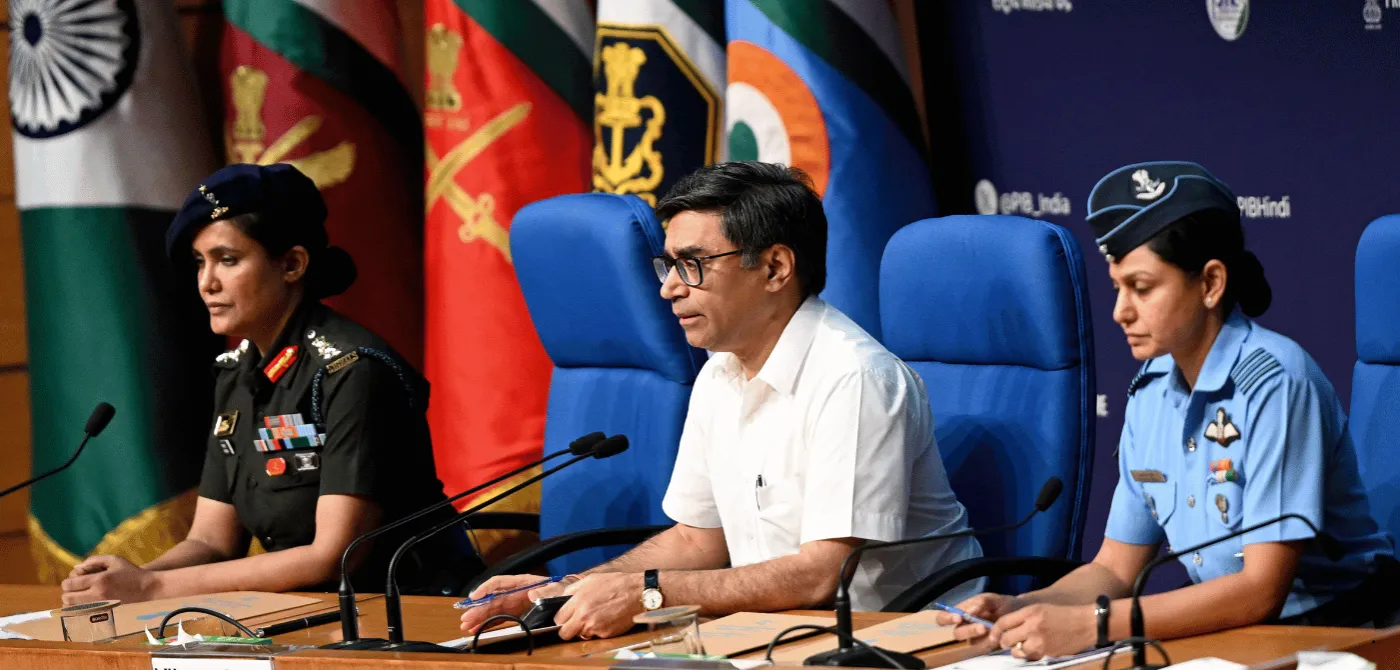A month and more has passed since India and Pakistan agreed to put on hold their skirmishes. Preliminary analyses of the military and political ramifications of this spike in violence have not resulted in definitive conclusions as regard its impact on the strategic situation of the sub-continent. A clearer picture might emerge when (or if) further details are revealed.
Build-up to Pahalgam
A re-examination of these events must start with the atrocity committed on April 22 in Pahalgam. This was not the only terrorist attack of recent times or the only one in which Hindus were specifically targeted. The attack on Vaishno Devi pilgrims a few months ago could have hit a more horrific scale than it did if the vehicle in which they were travelling had not fallen into a ravine. Pahalgam’s effect was of gut-wrenching intensity for the manner in which 26 Hindu men, holidaying with their families, were communally identified and shot to death in front of their wives, daughters and small children. Victims belonged to various parts of India and fury at the massacre was aroused all over. There was no denying the desire for revenge, and the government rode that sentiment
Although a recently-minted offshoot of the Lashkar-e-Tayyaba backed off from initial claims of responsibility, neither Indian officials nor public were distracted by the lack of evidence and linked the terror strike directly with Pakistan. The incident fitted neatly into a pattern formed over decades by which instantaneous denials or disclaimers had been proven false at the end of investigations. After all, Pakistan till today denies the involvement of its people in the 2008 Mumbai attacks though one of its operatives was convicted, sentenced and hanged at the end of a full judicial process. Leaders of United Nations-proscribed terror outfits roam around freely except for phases when they are taken into custody to allay international pressure before being let loose again.
Pakistani military rationale
Nor did it take long for a near consensus to form in India that Pahalgam had been ordered up by the Pakistan military for its own purposes. To once again bring the Jammu and Kashmir issue into international focus through a demonstration that normalcy had not been restored in the region was one presumable objective. Payback for recent flare-ups in insurgency in the Balochistan and Khyber Pakthoonkwa provinces, which Islamabad accuses New Delhi of inciting, could have been another. However, the prime objective seems to have been something else.
Munir seems to have decided to fall back on the old ploy of provoking India into fury so that the masses would rally behind the military when the bogeyman came for revenge.
Several spells of martial law in Pakistan, the despicable records of the dictators and the rapacity of the men in uniform have incrementally alienated civilians over the years. The chasm became visible and widened amidst the turbulence following the ouster of Imran Khan from the premiership in 2023. Qamar Javed Bajwa, Chief of Army Staff till he was replaced by the incumbent Syed Asim Munir Shah in November 2022, seemed to have acknowledged as much and tried to steer his institution and the country in a different direction. Bajwa spoke about democracy being the way forward for Pakistan and signaled that he would not be averse to rapprochement with India. Such talk was always going to be anathema to a section of the military. It had to find a way to stop any further movement in these directions and yet stem the alienation from the public. In these circumstances, Munir seems to have decided to fall back on the old ploy of provoking India into fury so that the masses would rally behind the military when the bogeyman came for revenge. It surely was no coincidence that mere days before Pahalgam, Munir addressed public meetings in which he asserted that Hindus and Muslims could never live together because they were different in every possible way.
Indian response
Given the widespread fury in India after April 22, it would probably have been difficult for any government in New Delhi to not contemplate a violent response. All the more so for a government and ruling party that equates belligerence with strength. India did retaliate by initial recourse to relatively soft options such as cutting off trade, reducing the diplomatic presence, suspending the grant of visas and, most drastically, by keeping the Indus Waters Treaty “in abeyance”. (Pakistan mirrored all steps bar the last). However, over the fortnight following Pahalgam there was very little doubt that the only question to be asked about a retaliatory military strike was as to when it would take place, not whether there would be one.
Details of all that unfolded between midnight of May 6-7 and the noon of May 10 need not be gone into here. To put it succinctly, the skirmishes began with the military striking 9 terrorist base camps in Pakistan and Pakistan-Kashmir. Among the targets destroyed or damaged were the main complexes of the Lashkar-e-Tayyaba in Muridke (not far from Lahore) and of the Jaish-e-Mohammed in Bahawalpur. Even as this assault was being wound down, the Director General of Military Operations contacted his Pakistani counterpart on the hotline and conveyed the message that all planned operations were over and no other targets, military or civilian would be struck.
Damage to military establishments and equipment [in India] was said to have been minimal. An Integrated Command and Control based air-defence network is believed to have worked effectively.
Around this time, Pakistani news outlets and some officials began putting out the claim, reiterated by the Pakistan Air Force top brass a day later, that their fighters had brought down as many as 6 Indian planes including Rafaels, Su-30s and Mig-29s. Independent analysts were of the opinion that such claims might suffice to make Pakistan believe that it had retrieved its honour and could therefore let matters come to a close. That was not to be. A little later the Director General of Pakistan’s Inter Services Public Relations went on air to broadcast a response that was apparently the same as the one given by his DGMO to the Indian. Pakistan would retaliate in the manner, time and place of its choosing.
What form that response would take was revealed over the next two nights. Swarms of drones and missiles were sent across the border and the Line of Control in attempts to destroy Indian military and civilian targets. These assaults were apparently directed at 36 sites from Srinagar in the North to Bhuj in Gujarat. Authorities in the Indian states confirmed the deaths of civilians and the destruction of buildings due to artillery shelling. Damage to military establishments and equipment was said to have been minimal. An Integrated Command and Control based air-defence network is believed to have worked effectively.
From the night of May 9 and through the forenoon of the next day, the IAF apparently went on the offensive. Corridors were blasted through Pakistan’s air defence screens and its airbases from Skaru in Gilgit to Malir near Karachi were struck by Indian missiles. Soon after the barrage ended, Pakistan’s DGMO got onto the hotline to Delhi and suggested that an end be put to the hostilities.
Sifting the evidence
What needs to be sorted out first off is the question of credibility since the versions put out by officials of the two sides are quite at variance. That essentially boils down to an evaluation of available evidence. Independent media reportage can only go so far in these circumstances, and they do not go beyond confirming casualties and damage on the civilian side. Access to military sites being restricted, there was little confirmation of official claims that damage to military installations had been minor.
However, it is almost a dead certainty that the news could not have been sealed off if the damage to Indian military facilities had been extensive. Bases are inhabited by personnel and families from every part of the country. News of a devastating hit would have cropped up somewhere and spread with viral force through cyber space. Pakistan also boasts that it has a wide network of spies. Surely one of them would have slipped in a record of damage if such did exist.
For the present, Indians will have to live with the admission of the Chief of Defence Staff General Anil Chauhan that aircraft loss did occur in the first phase on account of “tactical mistakes”.
In this day, when clear pictures of any spot on the earth can be purchased from private satellite companies at no great cost, Pakistan’s failure to do so demolished its claims. Much was made by them of severe damage inflicted on the Adampur airbase and the destruction of the S-400 anti-aircraft battery there, only for Prime Minister Narendra Modi to land there three days after the fighting finished and address base residents with the control tower and an S-400 battery as backdrops. For its part, the IAF was able to put out images of cratered runways and other damaged infrastructure in Chaklala, Sargodha, Bolari and other PAF bases.
As regards the downing of aircraft, the PAF claims it has traced the disappearance of radar signatures of the Indian aircraft. In the 2019 post Balakot affray, the IAF had made a similar claim about an F-16 purportedly brought down by (then) Wing Commander Abhinandan Varthaman. Claims about the shooting down of PAF planes have been made this time as well. Experts also say that radar signatures can be attached to decoys such as drones. Such claims and counter-claims are beyond the purview of laymen especially when they have no material to go by. For the present, Indians will have to live with the admission of the Chief of Defence Staff General Anil Chauhan that aircraft loss did occur in the first phase on account of “tactical mistakes”.
What if the mistakes made were attributable to guidelines set or limitations imposed on the military professionals by the political leadership?
Aerial combat of the sort carried out on the night of May 6-7 is an extremely complex affair. Masses of aircraft, flying at different heights and depths within their own respective air spaces undertake complex manouevres at high speed. Each side’s planes are not visible to the other through naked eyes and pilots rely on radars and other sensors. Mistakes and miscalculations can occur that can only be properly assessed by professionals. However, there are questions that laymen can ask.
What if the tactical mistakes were of the sort that uniformed personnel cannot talk about? What if the mistakes made were attributable to guidelines set or limitations imposed on the military professionals by the political leadership? These aspects too need to be delved into seriously.
Muddled approach
To take the enemy by surprise is a prime principle that must be followed by any attacking side. That was blown to bits by two weeks of rhetoric about the government of India’s intent to strike at terrorists and their sponsors. Such statements were to an extent excusable since South Block could not remain silent after Pahalgam. But it was inexcusable to assume that Pakistan would draw no conjectures about India’s plans. This point is being emphasized here because some government apologists have justified on the grounds of secrecy the breach of another cardinal principle.
Political sanction seems to have been given only for a repeat of the game-plan followed in 2019 when an aerial attack was carried out against a terrorist camp in Balakot.
So much has been written or spoken about the subject in the month since the conclusion of Operation Sindoor that many averagely informed laymen have learnt that offensive air operations must start with the Suppression of Enemy Air Defences (SEAD) or the Destruction of Enemy Air Defences (DEAD). Neither was apparently done at the start of this operation, not even after Pakistan noticed our build-up on the night of May 6-7 and began its preparations. From the commentaries put out by government sympathisers, the concern that India would be accused of “escalation” was a prime consideration behind the restraint.
Apprehension about inviting global criticism by pitching action at a high level from the outset seems to have also affected the choice of targets and plans. Political sanction seems to have been given only for a repeat of the game-plan followed in 2019 when an aerial attack was carried out against a terrorist camp in Balakot. It seems to have been not only a matter of telegraphing a punch but of also failing to anticipate the reaction. Was it out of a befuddling acceptance of Pakistan’s theory that there is daylight between its establishment and terror outfits? Did India’s political leadership actually believe that the Pakistan military would not react to attacks on Muridke and Bahawalpur especially when the post-Balakot action had shown that it would? These are the questions the Opposition ought to be asking. That would do more good than levelling silly accusations that Pakistan was warned before the attack on Muridke etc. or getting side-tracked into ascertaining numbers of aircraft losses.
A political leadership that is constantly boasting about its success in building India’s power seemed strangely uncertain about the nation’s might when it came to the crunch. If the IAF had been given the freedom to act in a professional mode, would it not have first degraded the PAF’s capacity to retaliate before taking care of the LeT etc.? Once it was relieved of the restraints imposed on it, the IAF showed what it could do as a professional fighting force. After successfully conducting defensive operations on May 7 and 8 it carried out SEAD/DEAD actions on May 8 and 9 before delivering its final blows on May 10.
Indian gains
If such a course had been followed from the outset it would have added weight to the theory now emerging. As per this version, Operation Sindoor has established India as a technologically savvy modern military power that can strike Pakistan at will. It could have been argued with greater credibility that the realization of this power differential was the single important factor that led Islamabad, or rather Rawalpindi to ask the United States to use its good offices to stop the fighting.
Pakistan has used its claimed success in downing Indian planes to muddy the picture. This is being presented as proof that the two countries are more or less on par militarily. The further implicit argument is that a conflagration between the two nuclear powered states could spin out of control and the international community must always be ready to intervene. This is the real disadvantage signified by the words “hyphenation” and “mediation”. Few countries are stupid enough to believe that Pakistan can benefit them economically, technologically or otherwise as much as India can. But the concern over a nuclear conflagration adds a different calculus to their policy making.
The question of what could have been done does not detract from some of the gains of Operation Sindoor. It has validated all the efforts put in over decades to develop technologically, economically and otherwise to make the country strong enough to look after itself. If this was an individual we were talking about it would be a moment for centering, for letting a sense of strength settle. Instead we have been subjected to a rhetorical barrage about doctrines that have not been thought through. Have the implications of some recent statements been weighed? Will any act of terror, irrespective of scale or nature, be actually considered an “act of war”? Will we draw no distinction between terrorist groups and countries that sponsor them?
…[T]he problem is structural because Pakistan cannot afford an armed force that devours national resources and constantly provokes a more powerful neighbour in order to justify its greed.
At the same time the formulation of policy and its enunciation do not seem to be the direct outcomes of inner conviction. Instead, formulation is apparently done under an overhanging cloud of apprehension about the reactions its implementation will elicit.
Whatever was happening in New Delhi was overshadowed by the weird drama being played out across the border. Munir, who had provoked a battering of his country’s air power while keeping himself and his army out of harm’s way, jumped a rank from General to Field Marshal. Pakistan’s military has latched on to unconfirmed and unassessed reports of tactical gains on May 7 as a tarpaulin to cover the losses it suffered later on.
Munir might have deluded himself into thinking that he has ended the alienation between his military and the masses. But the problem is structural because Pakistan cannot afford an armed force that devours national resources and constantly provokes a more powerful neighbour in order to justify its greed.
…Public antagonism in Pakistan towards the “khakis” will continue to grow and as it rises opportunities will open.
Pakistan’s military is unlikely to abandon its hostility towards India in the foreseeable future. Even when a section within it wakes up to the futility of this course, as Bajwa seemed to have desultorily done, it has too many chromosomes pushing it in the other direction. There does not seem to be any military solution to this problem as nuclear weapons could come into play if the armed forces there feel that their destruction is assured. However, public antagonism in Pakistan towards the “khakis” will continue to grow and as it rises opportunities will open.
For India, the best course would probably be one of quietly building its own strength. There is no need for the thumping of 56-inch chests.
Kesava Menon is a journalist and writer who was earlier Editor of Mathrubhumi.









